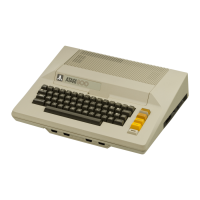Control Register B. CB2 can operate both as an input or output
control line. CB2 can be used in conjunction with CB1 to provide the
"handshake" between the microprocessor and a peripheral device. Each
time the microprocessor writes data to the PIA output register, CA2
control line is set high to signal the peripheral device. When the
data is read by the peripheral device it signals the microprocessor
by setting CB1 control line high.
RESET. Setting this line low resets all the registers in the PIA. It
also inhibits false outputs on the Port or Data Lines.
Input/Output Data Transfers.
The following paragraphs detail the procedures involved in typical
Input/Output operations.
Transfer of data to a peripheral device is performed by first writing
data to the PIA. The data is then put on the peripheral output line
for use by the peripheral device. The "handshake" procedure for the
output of data to a peripheral device is as follows:
1) The microprocessor signals the peripheral device that data
isavailable on the Data Out line (SOD) by setting the CA1
control line high.
2) The peripheral device reads the data and signals the
microprocessor that the data has been read by setting the CB
1 control line high.
3) The microprocessor can either make new data available to the
peripheral device, and the cycle would be repeated, or the
transfer of data can be terminated.
The peripheral input port on the PIA chip is used to transfer data to
the microprocessor. The data from the peripheral device is made
available on the input Data Bus.
1) The "handshake" procedure for the transfer of data from a
peripheral device to the input port is as follows:
2) The CA1 line goes high to interrupt the microprocessor to
indicate that data is available on the peripheral I/O
port.The microprocessor reads the data on the input data
line (SID) on the POKEY chip.
3) When the microprocessor has finished reading the available
data it signals the peripheral device by setting the CS2
line low.
ATARI Personal Computers 4-11
4.3.2.3 Key-IN Key-OUT Integrated Circuits. These two 4051 (Z101 and
Z102) integrated circuits are used to scan the Keyboard for input

